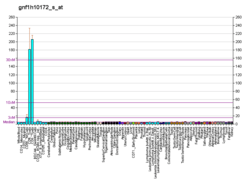P2RY8
P2Y purinoceptor 8 is a protein that in humans is encoded by the P2RY8 gene.[3][4]
Function
The protein encoded by this gene belongs to the family of G-protein coupled receptors, that are preferentially activated by adenosine and uridine nucleotides. This gene is moderately expressed in undifferentiated HL60 cells, and is located on both chromosomes X and Y.[4]
Clinical relevance
Recurrent mutations in this gene have been associated to cases of diffuse large B-cell lymphoma.[5]
See also
References
- 1 2 3 GRCh38: Ensembl release 89: ENSG00000182162 - Ensembl, May 2017
- ↑ "Human PubMed Reference:".
- ↑ Adrian K, Bernhard MK, Breitinger HG, Ogilvie A (Jun 2000). "Expression of purinergic receptors (ionotropic P2X1-7 and metabotropic P2Y1-11) during myeloid differentiation of HL60 cells". Biochimica et Biophysica Acta. 1492 (1): 127–38. doi:10.1016/S0167-4781(00)00094-4. PMID 11004484.
- 1 2 "Entrez Gene: P2RY8 purinergic receptor P2Y, G-protein coupled, 8".
- ↑ Lohr JG, Stojanov P, Lawrence MS, Auclair D, Chapuy B, Sougnez C, Cruz-Gordillo P, Knoechel B, Asmann YW, Slager SL, Novak AJ, Dogan A, Ansell SM, Link BK, Zou L, Gould J, Saksena G, Stransky N, Rangel-Escareño C, Fernandez-Lopez JC, Hidalgo-Miranda A, Melendez-Zajgla J, Hernández-Lemus E, Schwarz-Cruz y Celis A, Imaz-Rosshandler I, Ojesina AI, Jung J, Pedamallu CS, Lander ES, Habermann TM, Cerhan JR, Shipp MA, Getz G, Golub TR (Mar 2012). "Discovery and prioritization of somatic mutations in diffuse large B-cell lymphoma (DLBCL) by whole-exome sequencing". Proceedings of the National Academy of Sciences of the United States of America. 109 (10): 3879–84. doi:10.1073/pnas.1121343109. PMC 3309757. PMID 22343534.
Further reading
- Cantagrel V, Lossi AM, Boulanger S, Depetris D, Mattei MG, Gecz J, Schwartz CE, Van Maldergem L, Villard L (Oct 2004). "Disruption of a new X linked gene highly expressed in brain in a family with two mentally retarded males". Journal of Medical Genetics. 41 (10): 736–42. doi:10.1136/jmg.2004.021626. PMC 1735597. PMID 15466006.
- Fujiwara S, Yamashita Y, Choi YL, Watanabe H, Kurashina K, Soda M, Enomoto M, Hatanaka H, Takada S, Ozawa K, Mano H (May 2007). "Transforming activity of purinergic receptor P2Y, G protein coupled, 8 revealed by retroviral expression screening". Leukemia & Lymphoma. 48 (5): 978–86. doi:10.1080/10428190701225882. PMID 17487742.
- Storlazzi CT, Albano F, Lo Cunsolo C, Doglioni C, Guastadisegni MC, Impera L, Lonoce A, Funes S, Macrì E, Iuzzolino P, Panagopoulos I, Specchia G, Rocchi M (Oct 2007). "Upregulation of the SOX5 by promoter swapping with the P2RY8 gene in primary splenic follicular lymphoma". Leukemia. 21 (10): 2221–5. doi:10.1038/sj.leu.2404784. PMID 17554380.
This article incorporates text from the United States National Library of Medicine, which is in the public domain.
This article is issued from
Wikipedia.
The text is licensed under Creative Commons - Attribution - Sharealike.
Additional terms may apply for the media files.



